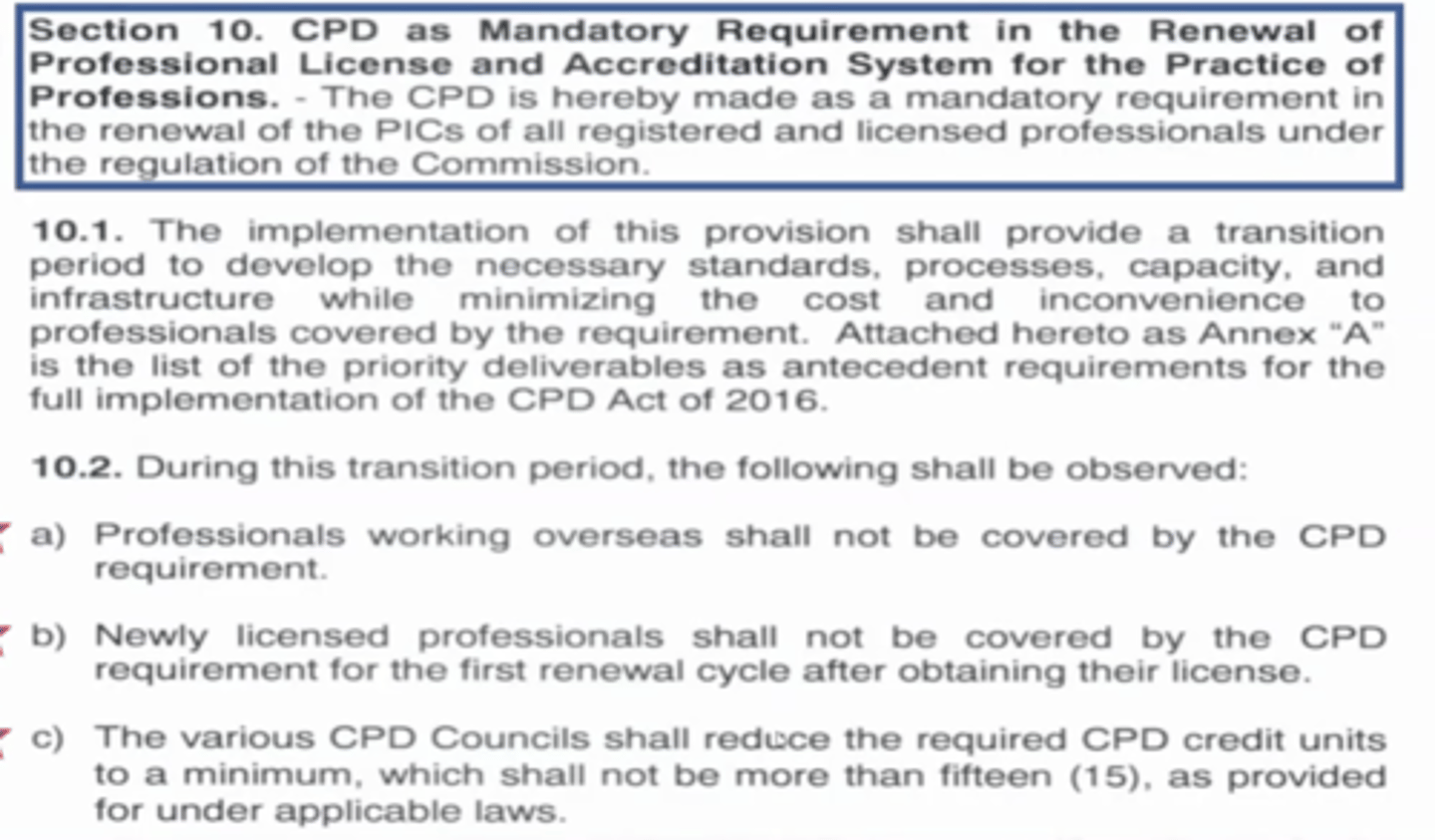[MTLE] RA 10912
1/53
There's no tags or description
Looks like no tags are added yet.
Name | Mastery | Learn | Test | Matching | Spaced |
|---|
No study sessions yet.
54 Terms
RA 10912
Continuing Professional Development Act of 2016
PQF and AQRF (Asean Qualifications Reference Framework)
standard framework (for comparisons) of qualifications across ASEAN regions
Lifelong learning
recognition of prior learning
pathways and equivalencies
Principle of the Driving Force of RA 10912
RA 10912
• Ensure continuous education and improvement in competence
• Means to update professionals on current trends and skills
• Mandatory
4 articles
Articles of RA 10912
19 sections
How many sections are in RA 10912
July 21, 2016
Approval date of RA 10912
March 15,2017
IRR of Resolution No. 1032
Benigno Aquino III
President approving RA 10912
PRC Resolution No. 1032 s. 2017
Implementing Rules and Regulations (IRR) of RA 10912
Implementing Rules and Regulations of RA 10912, Otherwise known as the continuing Professional Development Act of 2016
PRC Resolution No. 1032 s. 2017 TITLE
Continuing Professional Development Act of 2016
Sec 1, title of RA 10912
[Sec 2] Declaration of Policies
1) To promote and upgrade practice of professions
2) Institute measure to improve competence of professionals
3) Ensures contribution of professionals in development of country
AIPO or APO
Accredited Integrated Professional Organization
Accreditation Professional Organization
Continuing Education Development (CPD)
refers to the enculcation of advance knowledge and skills and ethical values in a post-licensure specialization or in an inter or multidisciplinary field of study, for assimilation into professional practice, self-directed research and/or lifelong learning
Lifelong Learning
Learning Activities undertaken throughout life for the development of competencies and qualifications of the professionals
Pathways and Equivalencies
Mechanisms that provide access to qualifications and assist professionals to move easily and readily between the different education and training sectors
Prior Learning
Person's skills, knowledge, and competencies that have been acquired through work experience, training, independent study, volunteer activities and hobbies, that may be applied for academic credit, as a requirement for a training program or for occupational certification
[Sec 4] Strengthening the CPD Program
1) enhance the competencies and qualifications of professionals
2) Ensure international alignment of competencies and qualifications of professionals
3) Ensure the development of quality-assured mechanisms
4) Ensure maintenance of core competencies and development
5) Recognize and ensure the contributions of professionals
1) Formal Learning
2) Nonformal learning
3) Informal Learning
4) Self-directed Learning
5) Online Learning Activities
6) Professional Work Experience
Nature of CPD [Sec 5]
can be structured or non-structured
Formal Learning
refers to educational arrangements such as curricular qualifications and teaching-learning requirements that take place in education and training institutions recognized by relevant national authorities, and which lead to diplomas and qualifications;
Nonformal Learning
refers to learning that has been acquired in addition or alternatively to formal learning, which may be structured and made more flexible according to educational and training arrangements;
Informal Learning
refers to learning that occurs in daily life assessed through the recognition, validation and accreditation process, and which can contribute to a qualification;
Self Directed Learning
refers to learning activities such as online training, local/international seminars nondegree courses, institution/company-sponsored training programs, and the like, which did not undergo CPD accreditation but may be applied for and awarded CPD units by the respective CPD Council.
Online Learning Activities
refer to structured or unstructured learning initiatives, which make use of the internet and other web-based Information and Communications Technology solutions;
Formal Learning
Refers to education as curriculum qualifications and teaching-learning requirements that take place in HEIs
1 CU per credit hour
University Certification of units earned
Additional Full CU upon completion of degree
University Certification/Diploma from the college
University Transcript of Records (authenticated)
Doctoral degree approved credit units
1 CU per credit hour
University Certification of Units earned
Full CU upon completion of degree
University Certification/Diploma from the college
University Transcript of Records (authenticated)
Master's degree approved credit unit
Full CU upon completion of degree
University Certification/Diploma from the college
University Transcript of Records (authenticated)
CU assigned by the CPH council
Diploma/Certification from the institution (authenticated)
Post-graduate Diploma/Certificate/Diplomate/Fellowship Program
Self directed learning
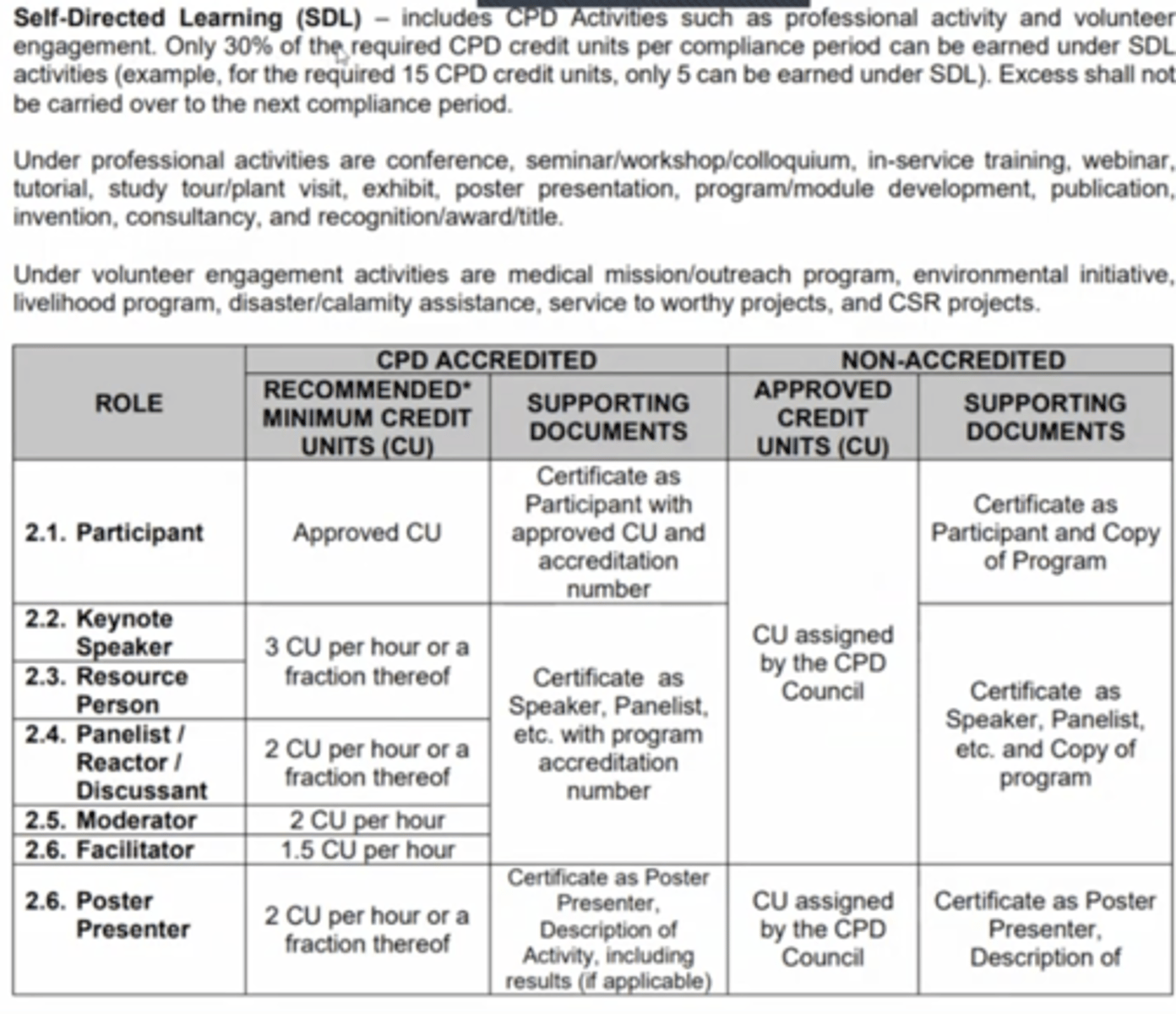
Other Learning Activities
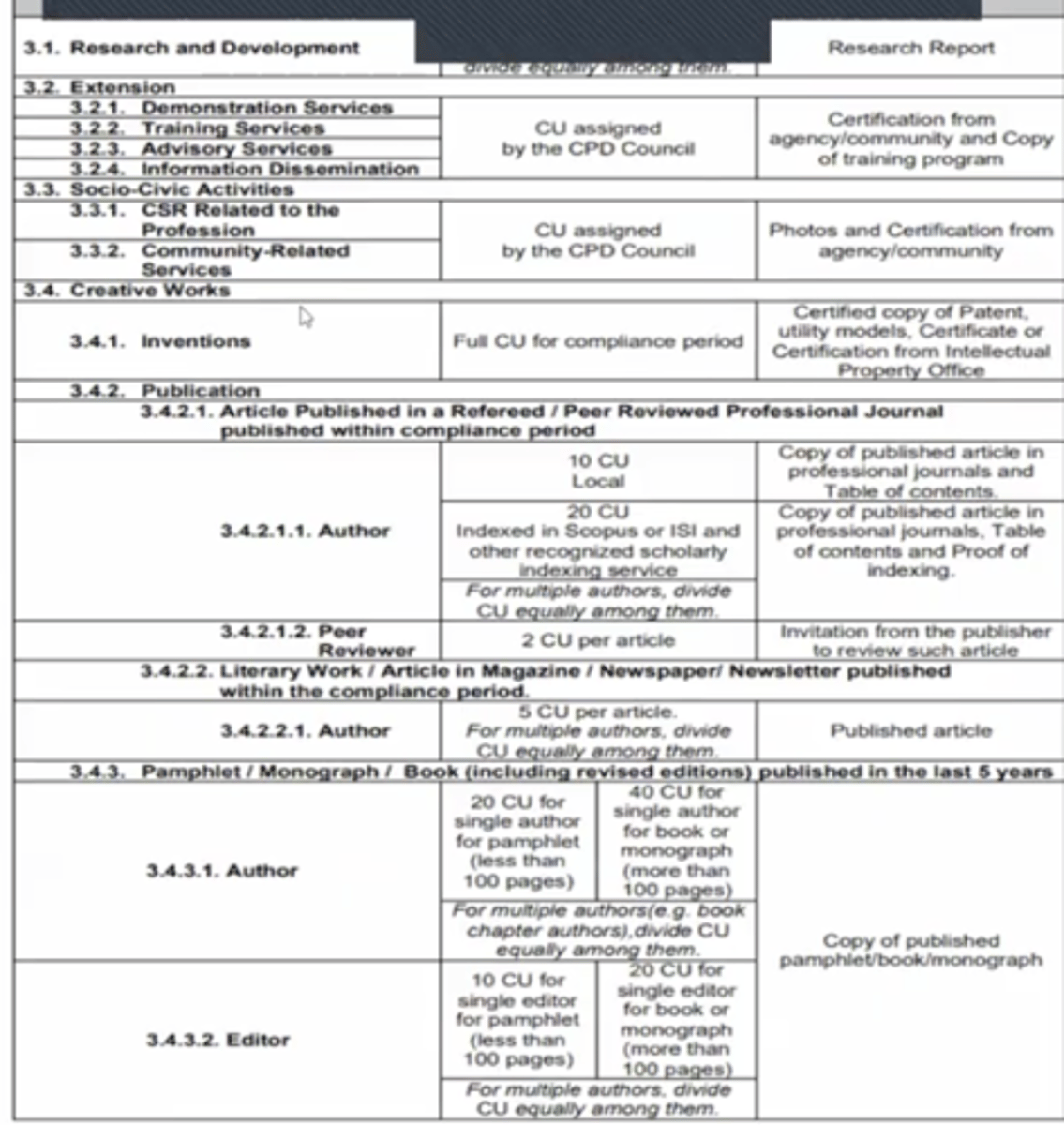
Informal Learning
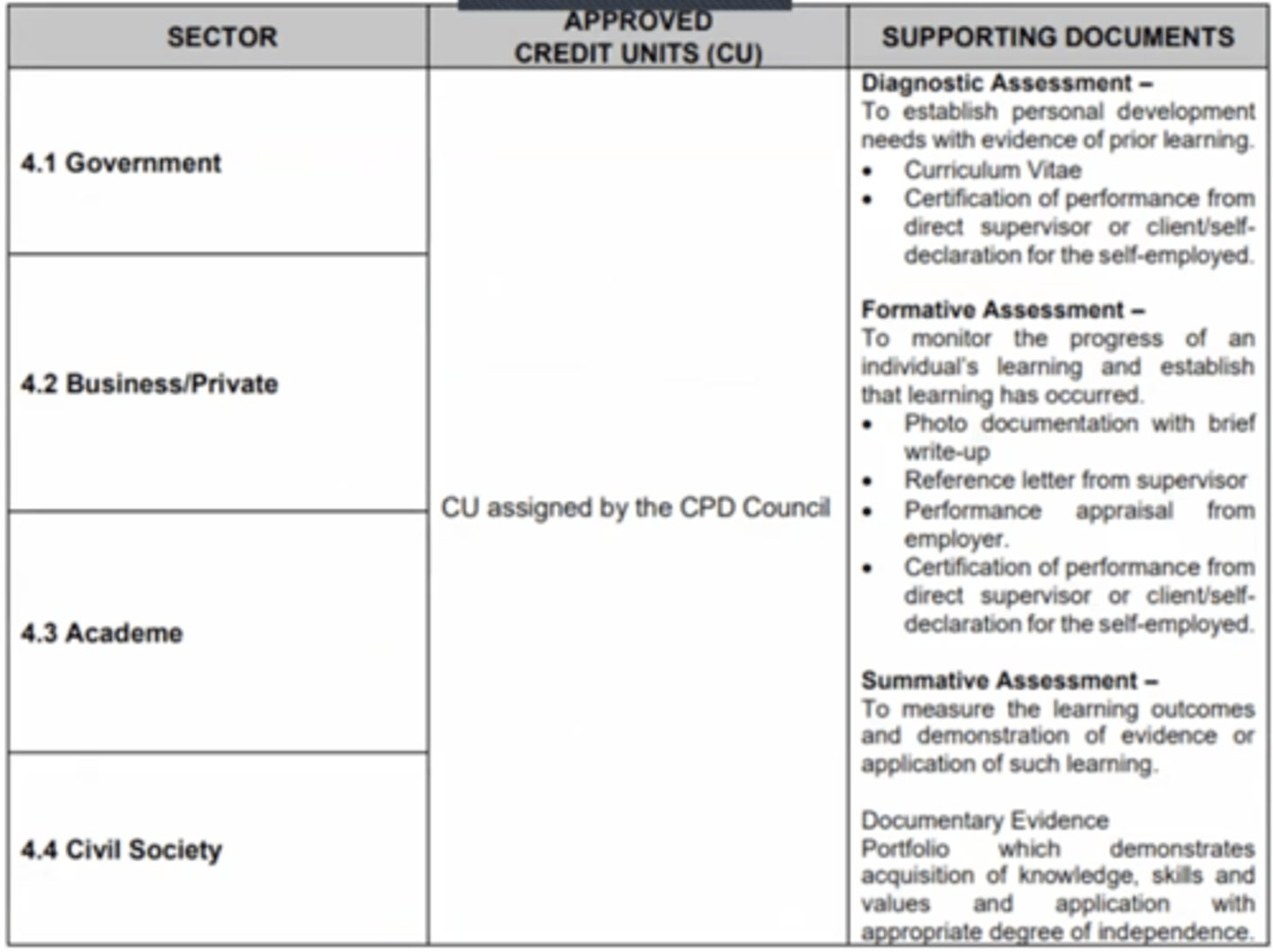
[Sec 6] Powers, Functions and Responsibilities of the PRC and the Professional Regulatory Boards (PRBs)
a. Organize CPD councils and promulgate guidelines for their operation
b. Review existing and new CPD programs
c. Formulate, issue, and promulgate guidelines and procedures
d. Coordinated the implementation of the CPD programs
e. Coordinate development of mechanisms and guidelines of credit units
[Sec 7] CPD Council
in each of the regulated professions, this shall be created which shall be under the supervision of the concerned PRB.
Chairperson and 2 members
Every CPD Council shall be composed of:
Chairperson of the CPD
shall be a member of the PRB
1st member of the CPD Council
member: president or officer of the AIPO/ APO duly authorized by its Board of Governors/ Trustees. In the absence of the AIPO/ APO, the PRB shall submit a list of three (3) recommendees from the national professional organizations.
2nd member of the CPD
president or officer of the national organization of deans or department chairpersons of schools. In the absence of such organization, the PRB shall submit a list of three (3) recommendees from the academe.
True
T/F:
The term of office of the chairperson of the CPD Council shall be coterminous with his/her incumbency in the PRB;
True
T/F:
The first and second members shall have a term of office of two (2) years
[Sec 8] Power, Functions and Responsibilities of CPD council
a. ensure the adequate and appropriate provisions of CPD Programs for their respective profession
b. evaluate and act on applications for accreditation of CPD Providers and their CPD Programs
c. monitor and evaluate the implementation of the CPD Programs
d. assess and or upgrade the criteria for accreditation of CPD Providers and their CPD Programs on a regular basis
[Sec 8] Power, Functions and Responsibilities of CPD council
e. Develop mechanisms for the validation, accreditation, and recognition of self-directed learning, informal learning, online learning and other learning processes through professional work experience
f. Conduct researches, studies and benchmarking for international alignment of the CPD Programs
g. Issue operational guidelines with the approval of the PRC and the PRB concerned
h. Perform such functions related or incidental to the implementation of the CPD
[Sec 9] Secretariat
Executive Director Appointed by the PRC
PRC
Who appoints the secretariat
Article III
CPD Program implementation and monitoring
Art 3, Section 10
CPD as Mandatory Requirement in the Renewal of Professional License and Accreditation System for the
Practice of Professions.
Art 3, Section 11
Recognition of Credit
Art 4, Sec 16
Fraud relating to CPD
[Sec 16] Fraud Relating to CPD
Fraudulent acts relating to the implementation and enforcement of this New Civil code and other applicable laws
A professional who is adjudged guilty of any fraudalent act relating to the CPD shall also be meted with the penalty of suspension or COR and COSpecialization
In case of a government official or employee, who is party to any fraudulent act relating to the CPD, he or she shall be subjected to the administrative penalties that may be imposed under the anti-graft laws, the Administrative Code and the Code of Conduct of Public Officials and Employees.
45 credit units
How many credit units do medtechs need to earn
PRC Res No. 2019-1146 s. 2019

PRC Res No. 2019-1146 s. 2019
Section 3.27. Professional Identification Card (PIC)
refers to the card bearing the registration number, dates of issuance and expiry, duly signed by the Chairperson of the Commission issued to a registered professional upon payment of fees. The PIC is renewable every three (3) years upon compliance with the requirements set by law.

PRC Res No. 2019-1146 s. 2019
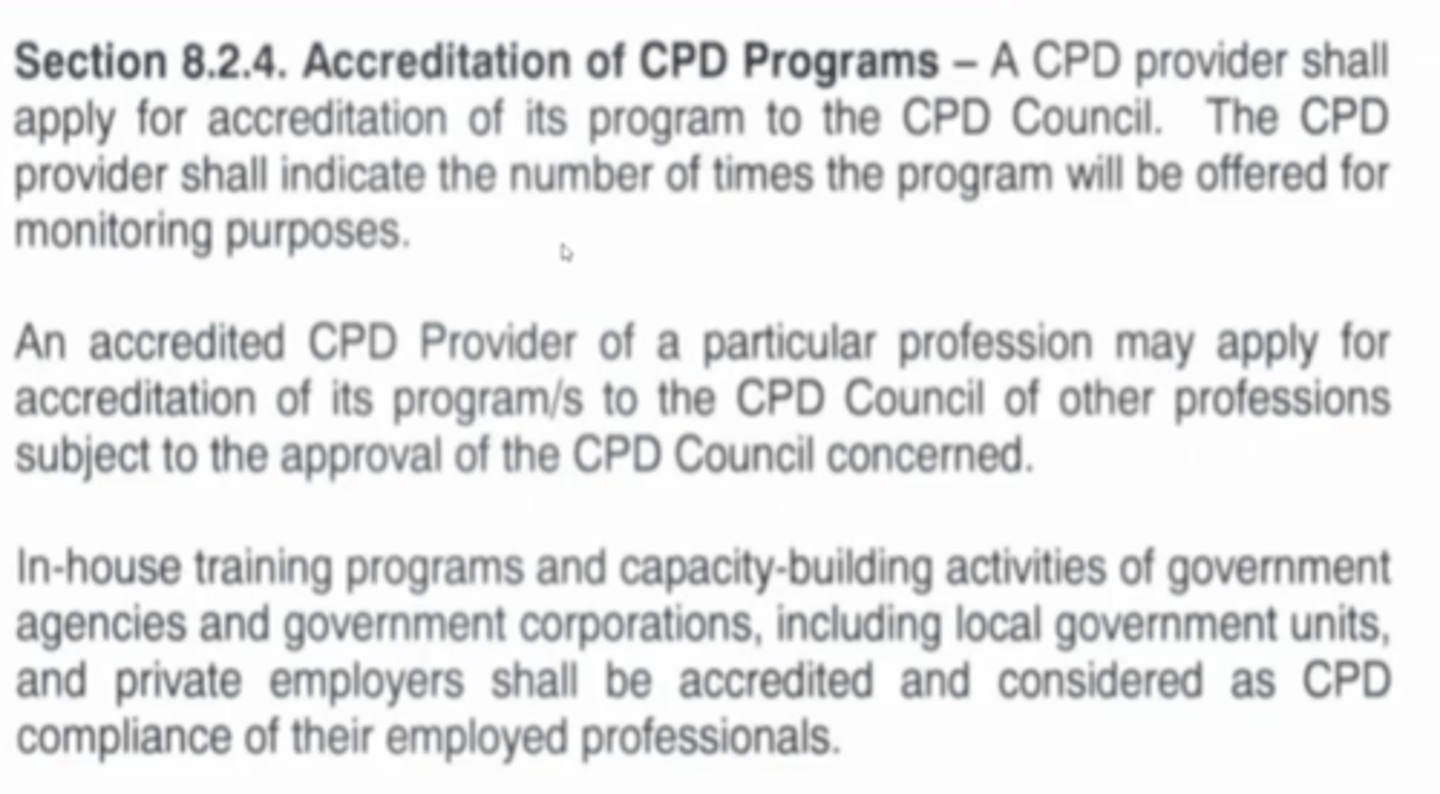
PRC Res No. 2019-1146 s. 2019
